Chinese newspapers aggregate in the basket of commode reading in my bathroom. I rarely look at them, as I always bring my own reading material. I noticed yesterday that there was an advertisement for a Chinese restaurant somewhere in the Triangle that listed a bunch of names of dishes. This is an uncommon occurance in the US, as people tend to think "beef and broccoli over rice" or "general tsao's chicken" when they think of Chinese cuisine. Not so fast. Those aren't actual names of dishes.
I don't know too much about nomenclature, but I'm pretty sure that Chinese dish names are like proper nouns - there is only one way to make it, and everybody calls it the same thing. Most of the time you can't tell from the name of the dish what it's made out of, simply because the name of the dish comes from some historic story that nobody remembers.
Example: One of the dishes advertised bye the new restaurant was "married couple's lung slices" (Foo Chi Fey Pian). mmmm yummy.
Tuesday, October 31, 2006
Saturday, September 09, 2006
Fong Da Coffee
My "big aunt" and I walked through this bizarre department store for young people who like to pretend they're Japanese, and ended up at this coffee shop to escape from the heat. Fong Da Coffee has been around since my "big aunt" first moved to Taipei when she was in college. I had no idea coffee, let alone coffee in Taiwan, had existed for so long. The coffee pot etched here in the metal tables of Fong Da Coffee is a Bialetti Moka Express, the original espresso maker.  These three are elaborate contraptions for ice cold brewed coffee. How do you cold-brew something? you ask. The truth is, I don't know. I have never seen these contraptions EVER, but they seem to be the next big thing in Taiwan. It's even more expensive than already-overpriced espresso! In a country where $100 NTDs (around $3 USD) can buy you a feast, spending close to $200 NTDs on a beverage is a WILD concept. It was worth it though, the coffee was smooth and mild without lacking in flavor. SO GOOD. All I know about it is that there's ice cold water in the top compartment that flows into the middle compartment, and the resulting mix dribbles down throw the spiral into the round bottomed flask at the end of the set up.
These three are elaborate contraptions for ice cold brewed coffee. How do you cold-brew something? you ask. The truth is, I don't know. I have never seen these contraptions EVER, but they seem to be the next big thing in Taiwan. It's even more expensive than already-overpriced espresso! In a country where $100 NTDs (around $3 USD) can buy you a feast, spending close to $200 NTDs on a beverage is a WILD concept. It was worth it though, the coffee was smooth and mild without lacking in flavor. SO GOOD. All I know about it is that there's ice cold water in the top compartment that flows into the middle compartment, and the resulting mix dribbles down throw the spiral into the round bottomed flask at the end of the set up.
 Ledena kava, Taiwanese style, in the clutches of my big aunt. Coffee flavored ice cream with coffee bits, in a glass of Fong Da's excellent cold coffee.
Ledena kava, Taiwanese style, in the clutches of my big aunt. Coffee flavored ice cream with coffee bits, in a glass of Fong Da's excellent cold coffee.
 I got this frozen concoction, which was much easier than the other cold coffee drink to make, but definitely did not taste as good.
I got this frozen concoction, which was much easier than the other cold coffee drink to make, but definitely did not taste as good.

 These three are elaborate contraptions for ice cold brewed coffee. How do you cold-brew something? you ask. The truth is, I don't know. I have never seen these contraptions EVER, but they seem to be the next big thing in Taiwan. It's even more expensive than already-overpriced espresso! In a country where $100 NTDs (around $3 USD) can buy you a feast, spending close to $200 NTDs on a beverage is a WILD concept. It was worth it though, the coffee was smooth and mild without lacking in flavor. SO GOOD. All I know about it is that there's ice cold water in the top compartment that flows into the middle compartment, and the resulting mix dribbles down throw the spiral into the round bottomed flask at the end of the set up.
These three are elaborate contraptions for ice cold brewed coffee. How do you cold-brew something? you ask. The truth is, I don't know. I have never seen these contraptions EVER, but they seem to be the next big thing in Taiwan. It's even more expensive than already-overpriced espresso! In a country where $100 NTDs (around $3 USD) can buy you a feast, spending close to $200 NTDs on a beverage is a WILD concept. It was worth it though, the coffee was smooth and mild without lacking in flavor. SO GOOD. All I know about it is that there's ice cold water in the top compartment that flows into the middle compartment, and the resulting mix dribbles down throw the spiral into the round bottomed flask at the end of the set up. Ledena kava, Taiwanese style, in the clutches of my big aunt. Coffee flavored ice cream with coffee bits, in a glass of Fong Da's excellent cold coffee.
Ledena kava, Taiwanese style, in the clutches of my big aunt. Coffee flavored ice cream with coffee bits, in a glass of Fong Da's excellent cold coffee. I got this frozen concoction, which was much easier than the other cold coffee drink to make, but definitely did not taste as good.
I got this frozen concoction, which was much easier than the other cold coffee drink to make, but definitely did not taste as good.
Big Wheel Sushi
My first encounter with my mom's oldest sister (big aunt) after 11 years of not seeing her was getting a cultural tour on Taiwanese teens, in Shi Men Ding. Our first stop (after passing by countless stores peddling pink, lacy, and anime accessories to teens with disposable income) was the Giant Wheel revolving sushi bar. I'm not sure why it's called Giant (da) Wheel (treh luen); maybe it has something to do with the train that was pulling the sushi? 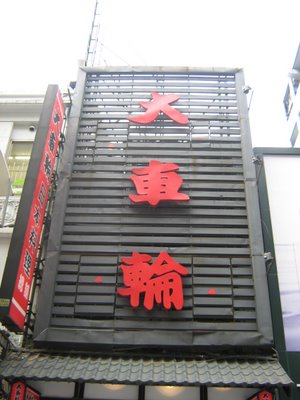 Left: Giant asparagus spears with a sour plum sauce. Very strange feeling, eating asparagus with plum. If you disregard the internal instinct to gag when you think of plum sauce, it's actually not bad.
Left: Giant asparagus spears with a sour plum sauce. Very strange feeling, eating asparagus with plum. If you disregard the internal instinct to gag when you think of plum sauce, it's actually not bad.
Right: noodles made out of a vegetable called mountain medicine (shan yao). It's more like shreds of some sort of root that comes out slimey but very subtle in taste.
Both are served cold.
 Cone, I think this is salmon.
Cone, I think this is salmon.
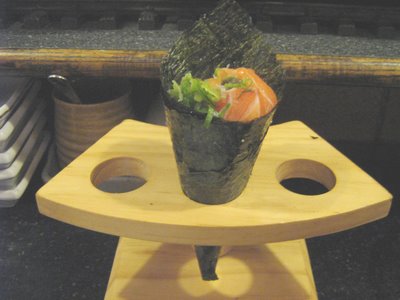 The REAL train pulling the sushi. Many revolving sushi restaurants have a conveyor belt that passes little covered dishes in front of diners. This restaurant put the effort into building a huge set of train tracks that went all the way around the dining room, from the front of the store to the back, taking great care to pass through the window display so that people outside can see too. They had to weigh down the train in certain areas because the food it was pulling was too heavy and would make the pulling engine tilt.
The REAL train pulling the sushi. Many revolving sushi restaurants have a conveyor belt that passes little covered dishes in front of diners. This restaurant put the effort into building a huge set of train tracks that went all the way around the dining room, from the front of the store to the back, taking great care to pass through the window display so that people outside can see too. They had to weigh down the train in certain areas because the food it was pulling was too heavy and would make the pulling engine tilt.
 Giant shrimp tempura. I love tempura because the batter is so light and crispy. The key to having excellent tempura batter is to mix the powder with ice water right before dipping food in it. This makes the batter light, and non-chewy.
Giant shrimp tempura. I love tempura because the batter is so light and crispy. The key to having excellent tempura batter is to mix the powder with ice water right before dipping food in it. This makes the batter light, and non-chewy.

 Left: Giant asparagus spears with a sour plum sauce. Very strange feeling, eating asparagus with plum. If you disregard the internal instinct to gag when you think of plum sauce, it's actually not bad.
Left: Giant asparagus spears with a sour plum sauce. Very strange feeling, eating asparagus with plum. If you disregard the internal instinct to gag when you think of plum sauce, it's actually not bad.Right: noodles made out of a vegetable called mountain medicine (shan yao). It's more like shreds of some sort of root that comes out slimey but very subtle in taste.
Both are served cold.
 Cone, I think this is salmon.
Cone, I think this is salmon. The REAL train pulling the sushi. Many revolving sushi restaurants have a conveyor belt that passes little covered dishes in front of diners. This restaurant put the effort into building a huge set of train tracks that went all the way around the dining room, from the front of the store to the back, taking great care to pass through the window display so that people outside can see too. They had to weigh down the train in certain areas because the food it was pulling was too heavy and would make the pulling engine tilt.
The REAL train pulling the sushi. Many revolving sushi restaurants have a conveyor belt that passes little covered dishes in front of diners. This restaurant put the effort into building a huge set of train tracks that went all the way around the dining room, from the front of the store to the back, taking great care to pass through the window display so that people outside can see too. They had to weigh down the train in certain areas because the food it was pulling was too heavy and would make the pulling engine tilt. Giant shrimp tempura. I love tempura because the batter is so light and crispy. The key to having excellent tempura batter is to mix the powder with ice water right before dipping food in it. This makes the batter light, and non-chewy.
Giant shrimp tempura. I love tempura because the batter is so light and crispy. The key to having excellent tempura batter is to mix the powder with ice water right before dipping food in it. This makes the batter light, and non-chewy.
Labels:
Shi Men Ding,
shrimp,
shrimp tempura,
sushi,
temaki
Om Hum Cafe
The one thing that I love about Taiwan (and Japan, and France, ok, and pretty much anywhere on earth except the US) is that they don't make a big distinction between commercial real estate and residential areas. It is completely normal to find a bakery, cafe, or restaurant next to somebody's laundry line. In Slovenia, our favorite and the most puzzling jedilnica was hidden somewhere in Vic (veech), next to some houses and the school. Things are so integrated, I can't even tell you where the grocery store was that we used to go to in Ljubljana. If you wanted me to find Cafe Oh Hum again, I probably couldn't tell you where it was. All I know is that we walked through Shih Da (National Taiwan Normal University) night market and wound up somewhere in a back alley beside an empty elementary school and a bunch of houses. The entrance was so secluded and hidden in vegetation that I was actually shocked to find the cafe almost full. Among the hip coffee bar crowd were some French people, and some people who pretended like they spoke French. I did not pretend like I spoke French, but secretly I was listening in on their conversation. It might have been about poodles...
If you wanted me to find Cafe Oh Hum again, I probably couldn't tell you where it was. All I know is that we walked through Shih Da (National Taiwan Normal University) night market and wound up somewhere in a back alley beside an empty elementary school and a bunch of houses. The entrance was so secluded and hidden in vegetation that I was actually shocked to find the cafe almost full. Among the hip coffee bar crowd were some French people, and some people who pretended like they spoke French. I did not pretend like I spoke French, but secretly I was listening in on their conversation. It might have been about poodles...
 I don't really understand why an Indian/buddhist themed cafe would have a kimono, but I'm not a professional at differentiating asian clothing, so that's ok.
I don't really understand why an Indian/buddhist themed cafe would have a kimono, but I'm not a professional at differentiating asian clothing, so that's ok.
 My iced coffee was perhaps overkill after the huge dinner we had at flower hotpot. The iced coffee part was a little too sweet, and there was too much cream at the top.
My iced coffee was perhaps overkill after the huge dinner we had at flower hotpot. The iced coffee part was a little too sweet, and there was too much cream at the top.
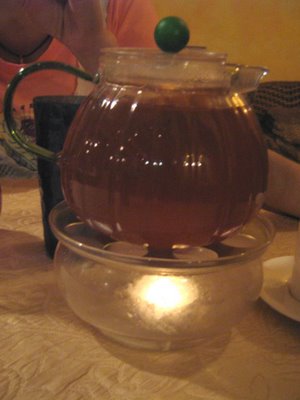 I would have probably been better off getting the citrus tea, something light to counteract overeating.
I would have probably been better off getting the citrus tea, something light to counteract overeating.
 If you wanted me to find Cafe Oh Hum again, I probably couldn't tell you where it was. All I know is that we walked through Shih Da (National Taiwan Normal University) night market and wound up somewhere in a back alley beside an empty elementary school and a bunch of houses. The entrance was so secluded and hidden in vegetation that I was actually shocked to find the cafe almost full. Among the hip coffee bar crowd were some French people, and some people who pretended like they spoke French. I did not pretend like I spoke French, but secretly I was listening in on their conversation. It might have been about poodles...
If you wanted me to find Cafe Oh Hum again, I probably couldn't tell you where it was. All I know is that we walked through Shih Da (National Taiwan Normal University) night market and wound up somewhere in a back alley beside an empty elementary school and a bunch of houses. The entrance was so secluded and hidden in vegetation that I was actually shocked to find the cafe almost full. Among the hip coffee bar crowd were some French people, and some people who pretended like they spoke French. I did not pretend like I spoke French, but secretly I was listening in on their conversation. It might have been about poodles... I don't really understand why an Indian/buddhist themed cafe would have a kimono, but I'm not a professional at differentiating asian clothing, so that's ok.
I don't really understand why an Indian/buddhist themed cafe would have a kimono, but I'm not a professional at differentiating asian clothing, so that's ok. My iced coffee was perhaps overkill after the huge dinner we had at flower hotpot. The iced coffee part was a little too sweet, and there was too much cream at the top.
My iced coffee was perhaps overkill after the huge dinner we had at flower hotpot. The iced coffee part was a little too sweet, and there was too much cream at the top. I would have probably been better off getting the citrus tea, something light to counteract overeating.
I would have probably been better off getting the citrus tea, something light to counteract overeating.
Monday, September 04, 2006
Paper Hotpot
After 11 years of not seeing my 2 best friends (ok, my only 2 friends in Taiwan), they took me out to "paper hotpot." A hotpot can be any variety of things where a liquid is heated in a pot and you dip things into it. It may include shabu shabu, sukiyaki, and I even include fondu, because you're still doing the dipping motion. Clockwise from black spoon on the right: the black spoon is flat and wide, used to manipulate the bits of food inside of the pot so that nothing is over- or undercooked; chopsticks in a paper sleeve; bowl of rice; special sauce that is typically spicy and salty, usually made of some sort of shrimp or brine; the paper hot pot with vegetables, corn, fish balls, taro root, and tofu.
The restaurant not only specializes in using paper as a pot, but using flower teas as the broth for the hotpot. What you can't see is a teabag of flowers somewhere buried under all the food in the pot. The paper pot can last up to 6 hours as long as the liquid level does not go under the first metal ring of the holder, and as long as the flame is burning. The water inside keeps the paper from burning, and the fire keeps the paper from becoming soggy and breaking. This particular ensemble was mine, called the "body trimming" package. It included shrimp, thinly sliced chicken, and some other stuff that you could put in your boiling flower tea.
 This ensemble was my childhood bestfriend's. I think it was the "beautifying" package, with a special blend of flowers in the tea that apparently "beautified."
This ensemble was my childhood bestfriend's. I think it was the "beautifying" package, with a special blend of flowers in the tea that apparently "beautified."
 This ensemble is my nextdoor neighbor's. I think it was "body fortifying", because she had been feeling a bit out of sorts.
This ensemble is my nextdoor neighbor's. I think it was "body fortifying", because she had been feeling a bit out of sorts.
 I still can't believe it was paper that was cooking on top of an open flame.
I still can't believe it was paper that was cooking on top of an open flame.
 The body fortifying package included little baby squids. So adorable to look at, a little creepy to eat.
The body fortifying package included little baby squids. So adorable to look at, a little creepy to eat.
 Mine was normal. Thinly sliced chicken, taro root, a bit of a gourd, shrimp, and part of a daikon.
Mine was normal. Thinly sliced chicken, taro root, a bit of a gourd, shrimp, and part of a daikon.
 This stuff was already in the hotpot when they brought them out. Green leafy vegetables, fish balls, quail eggs, taro root, daikon, carrot, corn, and broccoli rounded out the stew.
This stuff was already in the hotpot when they brought them out. Green leafy vegetables, fish balls, quail eggs, taro root, daikon, carrot, corn, and broccoli rounded out the stew.
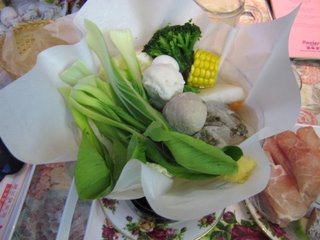 For dessert, despite having eaten a pot full of food each, we had small pieces of cheesecake and iced jasmine milk tea.
For dessert, despite having eaten a pot full of food each, we had small pieces of cheesecake and iced jasmine milk tea.

The restaurant not only specializes in using paper as a pot, but using flower teas as the broth for the hotpot. What you can't see is a teabag of flowers somewhere buried under all the food in the pot. The paper pot can last up to 6 hours as long as the liquid level does not go under the first metal ring of the holder, and as long as the flame is burning. The water inside keeps the paper from burning, and the fire keeps the paper from becoming soggy and breaking. This particular ensemble was mine, called the "body trimming" package. It included shrimp, thinly sliced chicken, and some other stuff that you could put in your boiling flower tea.
 This ensemble was my childhood bestfriend's. I think it was the "beautifying" package, with a special blend of flowers in the tea that apparently "beautified."
This ensemble was my childhood bestfriend's. I think it was the "beautifying" package, with a special blend of flowers in the tea that apparently "beautified." This ensemble is my nextdoor neighbor's. I think it was "body fortifying", because she had been feeling a bit out of sorts.
This ensemble is my nextdoor neighbor's. I think it was "body fortifying", because she had been feeling a bit out of sorts. I still can't believe it was paper that was cooking on top of an open flame.
I still can't believe it was paper that was cooking on top of an open flame. The body fortifying package included little baby squids. So adorable to look at, a little creepy to eat.
The body fortifying package included little baby squids. So adorable to look at, a little creepy to eat. Mine was normal. Thinly sliced chicken, taro root, a bit of a gourd, shrimp, and part of a daikon.
Mine was normal. Thinly sliced chicken, taro root, a bit of a gourd, shrimp, and part of a daikon. This stuff was already in the hotpot when they brought them out. Green leafy vegetables, fish balls, quail eggs, taro root, daikon, carrot, corn, and broccoli rounded out the stew.
This stuff was already in the hotpot when they brought them out. Green leafy vegetables, fish balls, quail eggs, taro root, daikon, carrot, corn, and broccoli rounded out the stew. For dessert, despite having eaten a pot full of food each, we had small pieces of cheesecake and iced jasmine milk tea.
For dessert, despite having eaten a pot full of food each, we had small pieces of cheesecake and iced jasmine milk tea.
Labels:
flower hot pot,
shabu shabu,
Taipei,
Taiwan,
火鍋
Wednesday, August 30, 2006
Gross
This has nothing to do with food, but I took some pictures for my aunt Josephine while we were wandering around Shi Men Ding one afternoon. Shi Men Ding is a smaller version of Shibuya (Tokyo, Japan) in Taipei. Commonalities: street food, hormone-charged tweens, pink/white frilly "cute things" for girls, cos-play stores, avalanche of advertising.
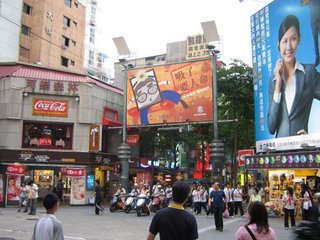 Shi Men Ding
Shi Men Ding
 Shibuya. V-Dub, representing Deutschland!
Shibuya. V-Dub, representing Deutschland!
 Shi Men Ding
Shi Men Ding Shibuya. V-Dub, representing Deutschland!
Shibuya. V-Dub, representing Deutschland!
Friday, August 25, 2006
Dinner on a Train, brought to you by 7-11
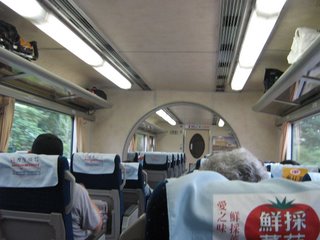 We rode the train back from Taitung to Taipei, bringing us past miles and miles of green, vast expanses of rushing waters. It felt like a page out of Goodbye South, Goodbye, only through the windows of a train and not on a motorcycle. We were going north. They in the movie were going all over Taiwan.
We rode the train back from Taitung to Taipei, bringing us past miles and miles of green, vast expanses of rushing waters. It felt like a page out of Goodbye South, Goodbye, only through the windows of a train and not on a motorcycle. We were going north. They in the movie were going all over Taiwan. Beverages are big. This is not the first or last time I rant about beverages in Taiwan. This bottle from the local 7-11 (or just "seven", in colloquial Taiwan-speak) is chocolate milk tea. What it actually tasted like was sugar plus water plus cheap non-fat dried milk and a hint of tea. I don't care. I still like beverages.
Beverages are big. This is not the first or last time I rant about beverages in Taiwan. This bottle from the local 7-11 (or just "seven", in colloquial Taiwan-speak) is chocolate milk tea. What it actually tasted like was sugar plus water plus cheap non-fat dried milk and a hint of tea. I don't care. I still like beverages. Even when the food stands have gone to bed for the night, you can still find all sorts of hot and cold food 24 hours a day at 7-11. This riceball has a very complicated system of packaging that keeps the dried seaweed wrapped around the rice separate until right when you remove the plastic for consumption. Don't ask me how it works. I just pull the arrows in the order they're numbered, and a fresh riceball with crispy seaweed appears.
Even when the food stands have gone to bed for the night, you can still find all sorts of hot and cold food 24 hours a day at 7-11. This riceball has a very complicated system of packaging that keeps the dried seaweed wrapped around the rice separate until right when you remove the plastic for consumption. Don't ask me how it works. I just pull the arrows in the order they're numbered, and a fresh riceball with crispy seaweed appears.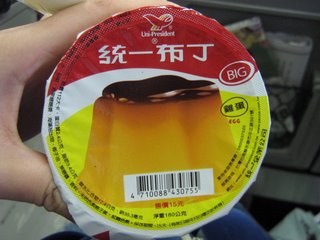 This is what I am referring to when I say pudding. It is most similar to Spanish flan, but more gelatinous and less creamy. When we were little, this was our snack of choice. There are a variety of ways to eat it. Perfectionists choose to dump it out inverted on a plate, like the serving suggestion pictured on the packaging. Some people eat it without mixing the dark caramel part with the eggy part. Me, I blend it all up into the smallest pieces I can possibly manage.
This is what I am referring to when I say pudding. It is most similar to Spanish flan, but more gelatinous and less creamy. When we were little, this was our snack of choice. There are a variety of ways to eat it. Perfectionists choose to dump it out inverted on a plate, like the serving suggestion pictured on the packaging. Some people eat it without mixing the dark caramel part with the eggy part. Me, I blend it all up into the smallest pieces I can possibly manage.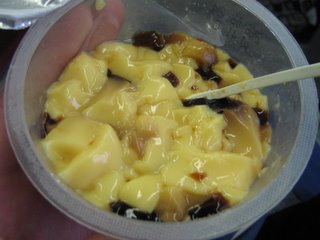 How do you eat yours?
How do you eat yours?
Monday, August 14, 2006
Mint tea
This is the view from the little house the B&B lady owned by the beach.

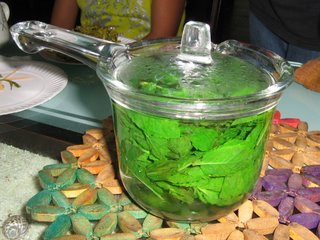 On the side of the house there are some mint plants, which, as evident here, can be plucked and placed in hot water to make fresh mint tea.
On the side of the house there are some mint plants, which, as evident here, can be plucked and placed in hot water to make fresh mint tea.

 The color is very light and the flavor is very subtle and refreshing.
The color is very light and the flavor is very subtle and refreshing.

 On the side of the house there are some mint plants, which, as evident here, can be plucked and placed in hot water to make fresh mint tea.
On the side of the house there are some mint plants, which, as evident here, can be plucked and placed in hot water to make fresh mint tea.
 The color is very light and the flavor is very subtle and refreshing.
The color is very light and the flavor is very subtle and refreshing.
Labels:
bed-and-breakfast,
mint tea,
Taidong,
Taiwan,
vacation lodge,
民宿
Bao-Ze
Dong Huh Bao Ze (east river bao ze) is the name of a shop that makes bao ze from a top secret recipe. Look! It even says it's 50 years old!

The story is, this store was started by the younger brother of a family that made bao ze. The original store was passed on to his older brother, but the mom decided to give the recipe to both her sons, and so they have a feud going on. The older brother's store has a lot more business, so we decided to patronize the younger brother's store. I mean, they make THE SAME product!
 There's no direct translation for bao ze into English, but you can see what they are. Fluffy dough wrapped around stuff. The stuff in the middle can be meat, or a mixture of meat and vegetables, or bean paste.
There's no direct translation for bao ze into English, but you can see what they are. Fluffy dough wrapped around stuff. The stuff in the middle can be meat, or a mixture of meat and vegetables, or bean paste.
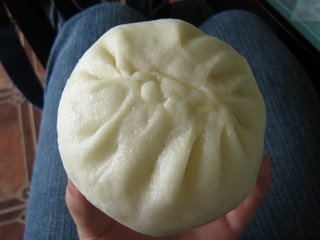 Every store has a system of labelling their boa ze so you know what's inside. Unlike a box of chocolates, where you never know what you're going to get, the labelling makes it easy for vegetarians to avoid the meat boa ze.
Every store has a system of labelling their boa ze so you know what's inside. Unlike a box of chocolates, where you never know what you're going to get, the labelling makes it easy for vegetarians to avoid the meat boa ze.
 While the meat bao ze didn't have any markings, the swan tsai (pickled leafy vegetables) bao has a pink dot on top.
While the meat bao ze didn't have any markings, the swan tsai (pickled leafy vegetables) bao has a pink dot on top.
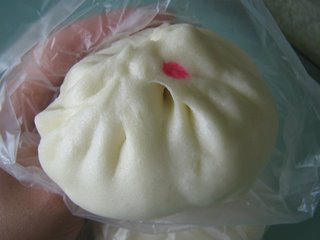
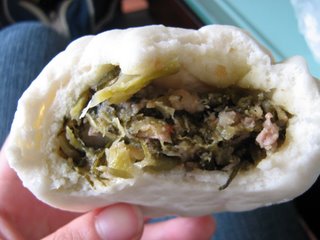

The story is, this store was started by the younger brother of a family that made bao ze. The original store was passed on to his older brother, but the mom decided to give the recipe to both her sons, and so they have a feud going on. The older brother's store has a lot more business, so we decided to patronize the younger brother's store. I mean, they make THE SAME product!
 There's no direct translation for bao ze into English, but you can see what they are. Fluffy dough wrapped around stuff. The stuff in the middle can be meat, or a mixture of meat and vegetables, or bean paste.
There's no direct translation for bao ze into English, but you can see what they are. Fluffy dough wrapped around stuff. The stuff in the middle can be meat, or a mixture of meat and vegetables, or bean paste. Every store has a system of labelling their boa ze so you know what's inside. Unlike a box of chocolates, where you never know what you're going to get, the labelling makes it easy for vegetarians to avoid the meat boa ze.
Every store has a system of labelling their boa ze so you know what's inside. Unlike a box of chocolates, where you never know what you're going to get, the labelling makes it easy for vegetarians to avoid the meat boa ze. While the meat bao ze didn't have any markings, the swan tsai (pickled leafy vegetables) bao has a pink dot on top.
While the meat bao ze didn't have any markings, the swan tsai (pickled leafy vegetables) bao has a pink dot on top.

Roadside Juice Stand
Papaya milkshake. AWESOME. Thing #238473 that I miss about Taiwan. The lady who makes the juices.
The lady who makes the juices.
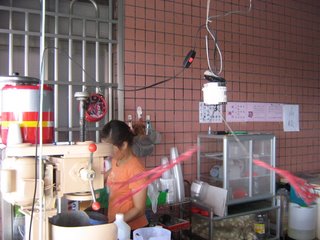 On the left, papaya. On the right, pineapple.
On the left, papaya. On the right, pineapple.
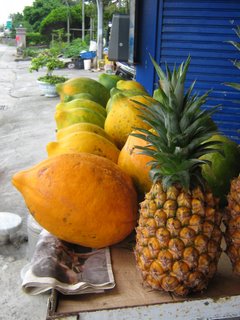 Because in Taiwan, pig skin and intestines are sold alongside wonderful fruit juices.
Because in Taiwan, pig skin and intestines are sold alongside wonderful fruit juices.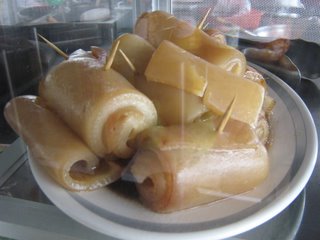
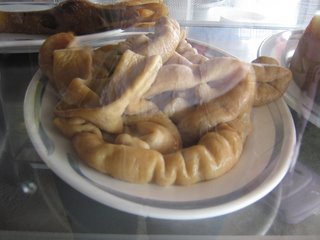
 The lady who makes the juices.
The lady who makes the juices. On the left, papaya. On the right, pineapple.
On the left, papaya. On the right, pineapple. Because in Taiwan, pig skin and intestines are sold alongside wonderful fruit juices.
Because in Taiwan, pig skin and intestines are sold alongside wonderful fruit juices.

Labels:
food-on-the-go,
intestines,
papaya milkshake,
Taidong,
Taiwan
Breakfast
What's better than fish eye soup for dinner? 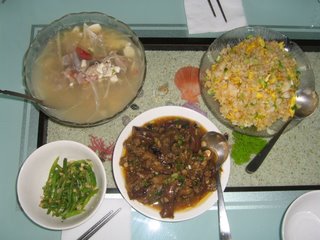 FISH EYE SOUP FOR BREAKFAST!!! Clockwise from the fish eye soup: fried eggs with daikon, spicy eggplant, greenbeans. All the dining tables at our B&B had inlays of sand and shells, quite delightful.
FISH EYE SOUP FOR BREAKFAST!!! Clockwise from the fish eye soup: fried eggs with daikon, spicy eggplant, greenbeans. All the dining tables at our B&B had inlays of sand and shells, quite delightful.
 FISH EYE SOUP FOR BREAKFAST!!! Clockwise from the fish eye soup: fried eggs with daikon, spicy eggplant, greenbeans. All the dining tables at our B&B had inlays of sand and shells, quite delightful.
FISH EYE SOUP FOR BREAKFAST!!! Clockwise from the fish eye soup: fried eggs with daikon, spicy eggplant, greenbeans. All the dining tables at our B&B had inlays of sand and shells, quite delightful.
Labels:
bed-and-breakfast,
breakfast,
fish eye soup,
Taidong,
Taiwan,
民宿
Monday, August 07, 2006
Wine and Dessert
I'm being really slow with the updates, I know. Here's a cheap but good pinot noir from Chile. I'm not a fan of Cabernets. If you want to appear like you know wines, definitely go with the pinots. Little known fact: Champagne is often made from the same grapes used to make pinot noir, a red wine. The type of grape determines not the color of the wine, as wine color is determined by how long the skin is in contact with the juice. I don't know if anybody makes wine with green grapes, but green grapes does not equal white wine. Chardonnay grapes are green, pinot grapes are really dark purple, but !gasp! sometimes a champagne can have both!
I'm not a fan of Cabernets. If you want to appear like you know wines, definitely go with the pinots. Little known fact: Champagne is often made from the same grapes used to make pinot noir, a red wine. The type of grape determines not the color of the wine, as wine color is determined by how long the skin is in contact with the juice. I don't know if anybody makes wine with green grapes, but green grapes does not equal white wine. Chardonnay grapes are green, pinot grapes are really dark purple, but !gasp! sometimes a champagne can have both!
 For dessert, we had a mille-crepe from a place called Deep Blue in Tainan. There's only one dessertery that makes it just right. A mille-crepe is just that - a thousand crepes piled on top of each other, with a thin layer of cream in between each layer. In actuality, I think they only have room to put about 30 layers before it just gets out of hand.
For dessert, we had a mille-crepe from a place called Deep Blue in Tainan. There's only one dessertery that makes it just right. A mille-crepe is just that - a thousand crepes piled on top of each other, with a thin layer of cream in between each layer. In actuality, I think they only have room to put about 30 layers before it just gets out of hand.
 I really liked the business card that came with our refrigerated-mail-delivered cake. It looks like the size of a normal business card but flips out to reveal the contact information for the store.
I really liked the business card that came with our refrigerated-mail-delivered cake. It looks like the size of a normal business card but flips out to reveal the contact information for the store.
 What you can't tell is that the other half of the mille-crepe is smashed from the rough handling during transport.
What you can't tell is that the other half of the mille-crepe is smashed from the rough handling during transport.
 I am a master at taking pictures of tasty things. Or at least, I felt like that after taking this photo, completely avoiding the smashed side while making the cake look presentable.
I am a master at taking pictures of tasty things. Or at least, I felt like that after taking this photo, completely avoiding the smashed side while making the cake look presentable.
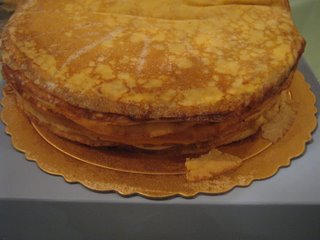
 I'm not a fan of Cabernets. If you want to appear like you know wines, definitely go with the pinots. Little known fact: Champagne is often made from the same grapes used to make pinot noir, a red wine. The type of grape determines not the color of the wine, as wine color is determined by how long the skin is in contact with the juice. I don't know if anybody makes wine with green grapes, but green grapes does not equal white wine. Chardonnay grapes are green, pinot grapes are really dark purple, but !gasp! sometimes a champagne can have both!
I'm not a fan of Cabernets. If you want to appear like you know wines, definitely go with the pinots. Little known fact: Champagne is often made from the same grapes used to make pinot noir, a red wine. The type of grape determines not the color of the wine, as wine color is determined by how long the skin is in contact with the juice. I don't know if anybody makes wine with green grapes, but green grapes does not equal white wine. Chardonnay grapes are green, pinot grapes are really dark purple, but !gasp! sometimes a champagne can have both! For dessert, we had a mille-crepe from a place called Deep Blue in Tainan. There's only one dessertery that makes it just right. A mille-crepe is just that - a thousand crepes piled on top of each other, with a thin layer of cream in between each layer. In actuality, I think they only have room to put about 30 layers before it just gets out of hand.
For dessert, we had a mille-crepe from a place called Deep Blue in Tainan. There's only one dessertery that makes it just right. A mille-crepe is just that - a thousand crepes piled on top of each other, with a thin layer of cream in between each layer. In actuality, I think they only have room to put about 30 layers before it just gets out of hand. I really liked the business card that came with our refrigerated-mail-delivered cake. It looks like the size of a normal business card but flips out to reveal the contact information for the store.
I really liked the business card that came with our refrigerated-mail-delivered cake. It looks like the size of a normal business card but flips out to reveal the contact information for the store. What you can't tell is that the other half of the mille-crepe is smashed from the rough handling during transport.
What you can't tell is that the other half of the mille-crepe is smashed from the rough handling during transport. I am a master at taking pictures of tasty things. Or at least, I felt like that after taking this photo, completely avoiding the smashed side while making the cake look presentable.
I am a master at taking pictures of tasty things. Or at least, I felt like that after taking this photo, completely avoiding the smashed side while making the cake look presentable.
Labels:
cabernet sauvignon,
Chile,
Deep Blue Bakery,
mille-crepe,
pinot noir
Subscribe to:
Posts (Atom)